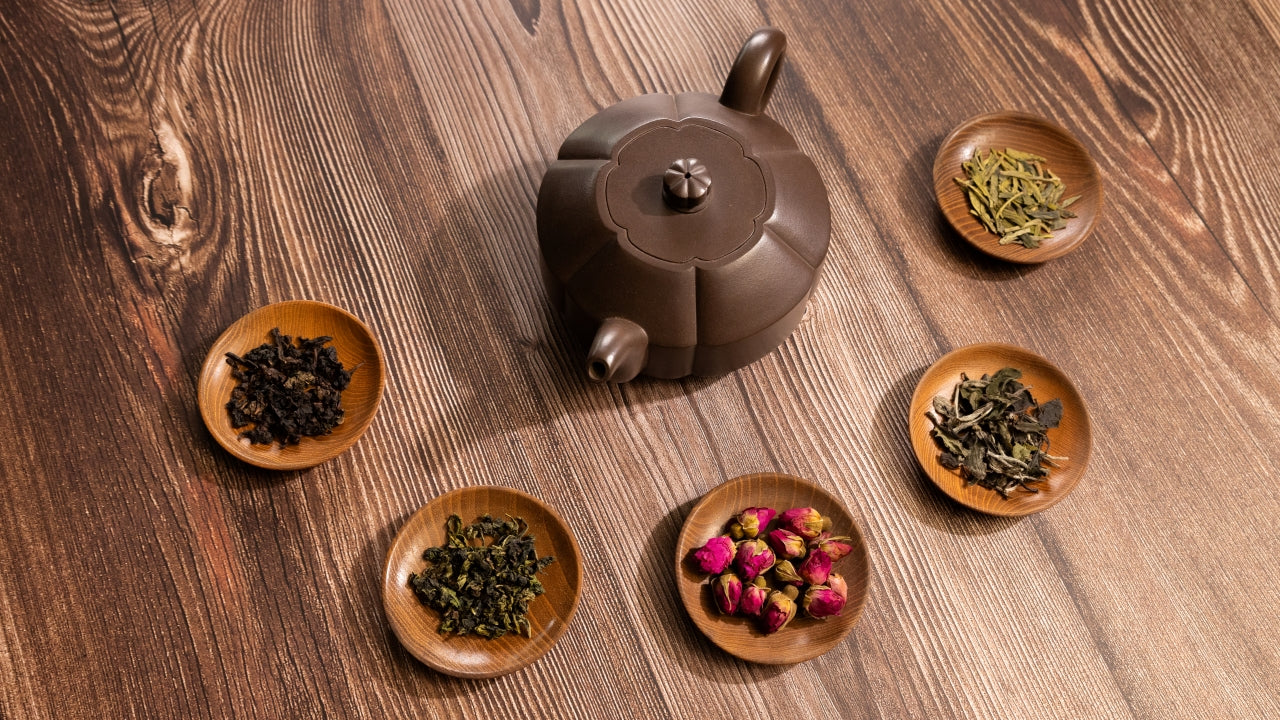
Types of Tea
Non-Fermented Tea
Tea leaves are harvested and immediately undergo a process called Shaqing (killing green) using baking, frying, sun-drying, or steaming to stop enzyme and cell activity. The leaves are then rolled to shape them (Green Tea, White Tea, Yellow Tea).
- Green Tea: Longjing and Biluochun are top examples known for their high catechin and antioxidant content.
- White Tea: Baimudan and Shoumei are unique as they are not rolled or fried but naturally dried.
- Yellow Tea: Involves the "Menhuang" process where the leaves are covered with cloth after picking, enhancing their aroma and developing the yellow tea soup.
Semi-Fermented Tea
(Mainly Oolong Tea, Qing Tea) After picking, the leaves are withered to lose internal moisture, then shaken in a rolling drum to activate moisture and enzymes again. This process is repeated 2-4 times to enhance fragrance and flavor. The leaves are then rolled to release flavor and baked to stop fermentation and shape them. All Semi-Fermented Tea are Qing Tea and categorized by regions.
- Minbei (Northern Fujian): Wuyi Mountain region - Dahongpao, Wuyi Rougui, Laocong Shuixian, Shuixian.
- Minnan (Southern Fujian): Anxi Tie Guan Yin - Fragrant type (light fire), Strong flavor type (heavy fire).
- Guangdong: Raoping County - Phoenix Dancong.
- Taiwan: High Mountain Tea.
Production Process: Harvesting, withering, shaking, blending, cooling, shaking, and blending again until the unique characteristics of Oolong tea are formed. Panning, rolling, and drying (stops the enzymatic activity in the leaf).
Fully Fermented Tea
Pile Fermentation (Mainly Black Tea and Ripe Pu'er) - After picking, the tea leaves are made into raw Maocha. Depending on the weather and region, they undergo water pile fermentation to mature, requiring temperature and humidity control. Finally, the tea is dried and shaped. Due to artificial water fermentation, this type of tea is darker in color and smoother in taste.
- Pu'er: Produced in Xishuangbanna, Simao, Lincang, and Yongde in Yunnan, divided into raw tea and ripe tea.
- Raw Tea/Qing Tea: Similar to green tea but must use sun-dried green Maocha from Yunnan. It requires long-term aging, at least 15-20 years, before reaching its optimal drinking period.
- Ripe Tea: Made from sun-dried green Maocha from Yunnan using water pile fermentation, resulting in a smooth and mellow taste suitable for all ages.
Our tea house has its own warehouse storing aged Pu'er tea cakes, bricks, and tuocha with professional blending of raw and ripe tea for rich flavors.
Processed Tea
Flower teas are artificially flavored with the original taste of the tea leaves; examples include Jasmine Tea, Osmanthus Tea, and Rose Tea. Additionally, there are Ginseng Oolong Tea, Lychee Black Tea, and others that cater to individual preferences.
- Jasmine Tea: Made with Fuzhou green tea and fresh jasmine flowers, repeatedly scenting for a fresh and vibrant taste.
- Liu An: Uses tender young green tea, high-fired and blended with osmanthus flowers for a rich aroma and flavor contrasting strongly with jasmine tea.
- Bao Bao Tea: Combines premium Yunnan Pu'er tea with rose flowers undergoing special natural processing. It is neither cold nor hot in nature, aiding digestion and suitable for all ages.
- Other: Lychee Black Tea, Ginseng Oolong Tea, etc.
